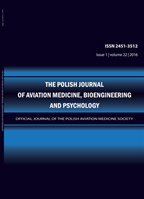2016, Volume 22, Issue 1
Compensation of Head Movements in the Data Registered with a Headset Eye Tracker Using the EVM* Software Package
Bibianna BAŁAJ1, Piotr FRANCUZ2, Marek STERNAL3, Jacek MATULEWSKI3
-------------------------------------------------------------------------------------------------
1Faculty of Humanities, Institute of Philosophy, Nicolaus Copernicus University in Torun
2Faculty of Social Sciences, Institute of Psychology, Department of Experimental Psychology, John Paul II Catholic University of Lublin
3Faculty of Physics, Astronomy and Applied Informatics, Institute of Physics, Nicolaus Copernicus University in Torun
Autor korenspondencyjny: Jacek MATULEWSKI; Faculty of Physics, Astronomy and Applied Informatics, Institute of Physics, Nicolaus Copernicus University in Torun; email: jacek[at]phys.uni.torun.pl
Full text
Streszczenie
Introduction: Comparative analysis of the data gained from headset eye tracker during driving a motor vehicle (eg. plane or car) is exposed to numerous errors and approximations. It is caused by head movements of the pilot or driver in relation to fixed elements in the cockpit of the motor vehicle, and - in the case of the simulator – to fixed elements exposed outside the cockpit (eg. the same cloud pattern or objects along the street). The movement of the head causes the image captured by the camera headset changes. As a result, the position of fixation points inside the areas of interest (eg. the speedometer) is stored in a various coordinate systems relative to the edges of the current image.
Methods: Our solution is based on an automatic image analysis, allows mapping of the gaze positions recorded in the flight simulator during performing the tests by pilots to the fixed system of the coordinates of the simulator monitormonitor. This solution has been implemented in the original software package Eye View Mapping (EVM). As part of the software testing we exported 200 random samples from the flight profiles and conducted a comparison of visual fixation in the regions of interest before and after the transformation.
Results: We presented the detailed steps in the analysis and transformation of the image using EVM and comparing a position gaze before and after the coordinate transformation. Gaze fall on the artificial horizon indicator more often, then on the external view and altimeter.
Positions before and after transformation coincide one hundred percent.
Conclusions: The solution implemented in the software package EVM allows you to automate the conversion of oculomotor data and prepare them for further analysis.
Słowa kluczowe
eye movements, flight simulator, visual analysis, automatization, oculography
